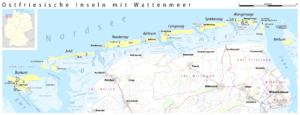Second Battle of Heligoland Bight facts for kids
Quick facts for kids Second Battle of Heligoland Bight |
|||||||
|---|---|---|---|---|---|---|---|
| Part of the First World War | |||||||
 HMS Calypso at the battle, during which she was severely damaged, drawn by William Lionel Wyllie |
|||||||
|
|||||||
| Belligerents | |||||||
| Commanders and leaders | |||||||
| Strength | |||||||
| 3 battlecruisers 8 light cruisers 10 destroyers |
2 battleships 4 light cruisers 8 destroyers 14 minesweepers |
||||||
| Casualties and losses | |||||||
| 22 men killed, 43 wounded 1 light cruiser damaged |
21 men killed, 40 wounded, 22 prisoners of war 1 minesweeper sunk 1 light cruiser damaged |
||||||
The Second Battle of Heligoland Bight was a naval battle during the First World War. It happened on November 17, 1917, between British and German ships. The battle took place in the Heligoland Bight, an area of the North Sea. Neither side won a clear victory, so it is called an "inconclusive" battle.
Contents
Why Did the Battle Happen?
British Mine Laying Tactics
During World War I, the British Navy used sea mines a lot. They placed mines to protect their own shipping routes. They also used mines to stop German submarines and ships from moving freely in the North Sea.
Mines were a real danger. For example, in October 1917, two German ships, SMS Brummer and SMS Bremse, attacked a British convoy. This event showed how important it was to stop German ships. British mines sank six German submarines in 1917. The Germans also lost many ships trying to clear these mines.
German Ship Movements
The British laid so many mines that the German Navy had trouble moving their ships. The Germans had to constantly clear paths through the minefields. These mine-clearing missions were called "Test trips."
These "Test trips" were big operations. They involved special ships to find mines, along with minesweepers, destroyers, and light cruisers. Even large battleships sometimes helped protect these missions. Airplanes and Zeppelins also flew overhead to scout for dangers.
Planning the Battle
British Intelligence Gathering
The British had a secret team called Room 40. This team was very good at breaking German codes. In October 1917, they learned about German plans. They found out that a German submarine was scouting for a new British convoy route.
They also heard that a large German attack with many cruisers and destroyers was coming. By mid-November, the British knew enough to plan an attack on one of the big German mine-clearing operations. They decided to launch their attack on November 17.
German Test Trip Plans
The Germans planned a "Test trip" for November 17, 1917. This trip involved many minesweepers, torpedo boats (destroyers), and light cruisers. Rear-Admiral Ludwig von Reuter led this group.
Two large German battleships, SMS Kaiser and SMS Kaiserin, were also part of the plan. They were there to protect the smaller ships. Bad weather meant that airships and seaplanes could not help with scouting. So, the Germans relied on two land-based seaplanes from Borkum for reconnaissance.

British Attack Plan
Because Room 40 had broken the German codes, the British knew exactly when and where the German "Test trip" would happen. This allowed them to set up an ambush.
On November 16, Admiral Sir David Beatty, the leader of the British Grand Fleet, received orders for the attack. On November 17, a strong group of British cruisers and destroyers, led by Vice Admiral Trevylyan Napier, sailed out to attack the German minesweepers.

The Battle Begins
The battle started at 7:30 a.m. British ship Courageous spotted the German ships first. She opened fire a few minutes later. Admiral Reuter quickly moved his four light cruisers and eight destroyers forward. Their goal was to protect the minesweepers so they could escape. All but one German trawler managed to get away.
The German ships then tried to escape by moving south-east as fast as they could. They used clever smokescreens to hide themselves. British ships, including Repulse, chased them. Both sides had to be careful because of the many minefields in the area.
Around the same time, the German battleships Kaiser and Kaiserin joined the fight. They fired at the British light cruisers. Caledon was hit, damaging one of its gun turrets. Soon after, the British ships stopped their chase as they reached the edge of more minefields.
A shell hit the British light cruiser Calypso. This hit killed the crew in the ship's control tower and badly wounded the Captain. The battlecruiser Repulse also fired at the German ships. It hit the German light cruiser SMS Königsberg, causing a serious fire.
What Happened After the Battle?
People Injured or Lost
The Germans reported that 21 of their sailors were killed. Ten were seriously wounded, and 30 were slightly wounded. The British reported that one officer and 21 sailors were killed. Four officers and 39 sailors were wounded. The British also took 22 German sailors as prisoners.
A Hero's Award
A British sailor named John Carless was on the ship Caledon. He was badly injured by shrapnel, but he kept loading and firing his gun. For his amazing bravery, he was given the Victoria Cross. This is the highest award for bravery in the British military. Sadly, he received it after he died from his wounds.
Ships Involved in the Battle
British Ships
|
German Ships
|

